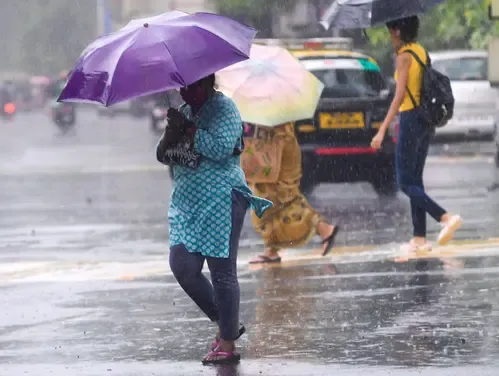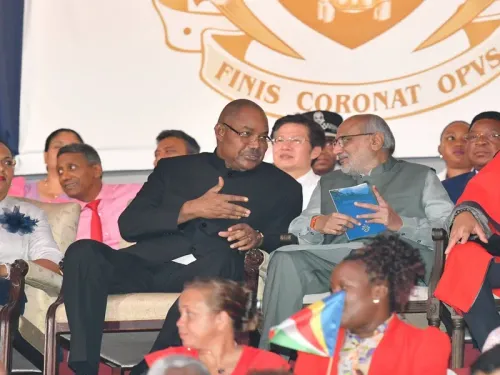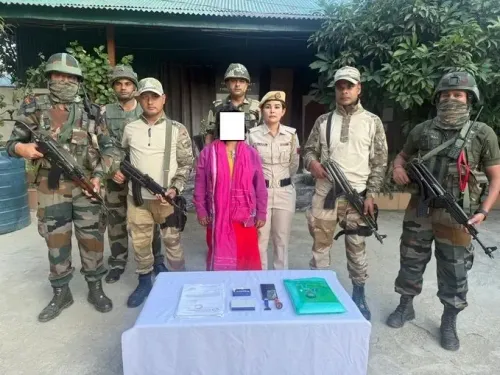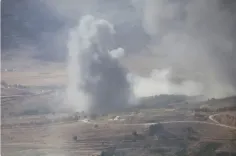Is Maoism on the Decline? 21 Maoists Surrender in Kanker District, Chhattisgarh

Synopsis
Key Takeaways
- 21 Maoists surrendered in Kanker district, including senior leaders.
- The group handed over 18 advanced weapons as part of their surrender.
- Government initiatives like ‘Puna Margem’ are fostering hope and trust.
- Over 1,200 cadres have surrendered statewide this year.
- Chhattisgarh targets a Naxal-free state by 2026.
Raipur, Oct 26 (NationPress) In the 127th episode of Mann Ki Baat, Prime Minister Narendra Modi highlighted that Maoism is on the verge of decline in India. On the same day, 21 hardline Maoists, including senior leaders, surrendered to authorities in Antagarh, Kanker district. They handed over 18 advanced weapons, significantly supporting the state’s anti-LWE efforts under the ‘Puna Margham’ rehabilitation initiative.
In response to this significant surrender, Chief Minister Vishnu Deo Sai shared on his X account, “The ‘Puna Margem – Rehabilitation to Regeneration’ initiative is proving to be a powerful catalyst in Bastar, dismantling the destructive ideology of Maoism and paving the way for a new chapter of peace and development. Today's surrender of 21 Naxalites in Kanker district is a reaffirmation of the success of our ‘Surrender and Rehabilitation Policy – 2025’ and the ‘Niyad Nella Naar Scheme’.
“These initiatives are cultivating trust and hope in areas that have long been marred by extremism. Young individuals, once seduced by the false allure of Maoist ideology, are now choosing the path of growth and opportunity. The transition from violence to progress is a testament to a broader understanding that sustainable development is achieved through constructive engagement, not conflict. The government is dedicated to ensuring that surrendered Naxalites are reintegrated into society with dignity and purpose.”
The group of surrendering cadres included four Division Vice Committee Members (DVCMs), nine Area Committee Members (ACMs), and eight party members, with 13 women and eight men among them. Significantly, Division Committee Secretary Mukesh, a prominent figure in the Keshkal Division (North Sub-Zonal Bureau), was included in this group. All had been involved in the Kuemari and Kiskoda Area Committees for years, committing acts of violence in the Antagarh region. They arrived from Barrebeda village early in the morning, escorted by a police team to a local camp, according to police officials.
The confiscated weapons comprised three AK-47 rifles, four Self-Loading Rifles (SLRs), two INSAS rifles, six .303 rifles, two single-shot rifles, and one Barrel Grenade Launcher (BGL) — a total valued at over ₹10 lakh in black-market terms. This surrender follows the capitulation of 50 Naxalites at the Kamteda camp just the day before, highlighting a noticeable rise in defections.
“This transformation is a result of the visionary leadership of Prime Minister Narendra Modi and the strategic oversight of Union Home Minister Amit Shah. Their initiatives have restored public trust in governance across Bastar, diminishing Maoist influence and motivating more individuals to leave violence behind. The Bastar region, once a bastion of LWE, is now on a fast track towards peace and development. Various infrastructure projects, livelihood programs, and community outreach initiatives are reshaping the socio-economic landscape. The government's ‘double-engine’ model — powered by both central and state leadership — is unwavering in its commitment to achieving a Naxal-free India by March 31, 2026,” CM Sai stated.
“The surrender of 21 Naxalites is more than just a statistic — it symbolizes change, embodies the power of inclusive governance, and serves as a beacon of hope for communities that have long been under the reign of insurgency. As more youth opt for education, employment, and empowerment over extremism, Bastar stands ready to evolve into a model of resilience and renewal.”
According to data from Chhattisgarh Police, there has been a dramatic decrease in Maoist activity this year. Since January 2025, over 1,200 cadres have surrendered statewide, turning in more than 900 weapons, including 150 AK-47s and INSAS rifles. Bijapur reported 410 surrenders by October, while Dantewada saw 71 in September alone, with many attributing their decision to disillusionment with Maoist ideology and improved security.
Union Home Minister Amit Shah, in a recent statement, credited these efforts for a 40 percent reduction in Naxal violence, with incidents in Bastar down by 25 percent year-on-year. Authorities have begun rehabilitation for these individuals, including medical assessments and vocational training. With over 1,400 surrenders reported since 2023 under the policy, Chhattisgarh aspires to become a “Naxal-free” state by 2026, focusing on economic integration to maintain peace in the Red Corridor.









